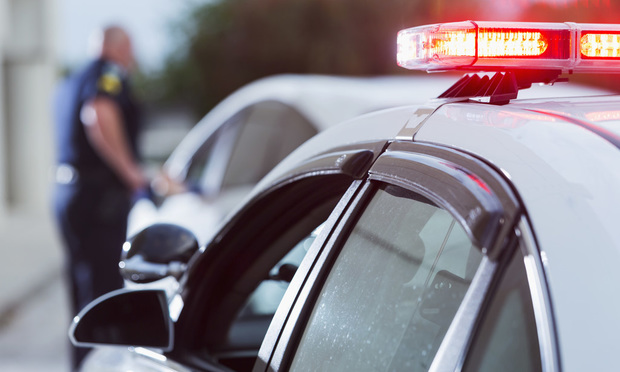DWI Checkpoints: Checking All the Boxes
OP-ED: There are important Constitutional issues arising from a checkpoint stop that should be considered.
December 31, 2018 at 09:00 AM
6 minute read

DWI cases often begin with a driver being stopped at what is referred to as a DWI checkpoint. From the standpoint of defending drivers charged with Driving While Intoxicated, there are important Constitutional issues arising from a checkpoint stop that should be considered.
As a basic Constitutional principle, individuals acting on behalf of the State such as Police Officers and State Troopers, cannot stop motor vehicles unless they can justify the stop. Both the United States and New Jersey Constitutions require that the State demonstrate a reasonable and articulable suspicion that the law has been violated before an officer can intrude upon the driver's right to travel without State interference. Simply stated, the State has to make some showing that a law has been violated before a car can be stopped. If not, the State will be prevented from having evidence acquired as a result of that stop considered by the court. In the case of a DWI prosecution, this could include evidence of the driver's intoxication, which could be crucial to the State's ability to prove the driver's guilt.
Obviously, cars stopped at DWI checkpoints are not stopped because of a motor vehicle violation. Rather, they are stopped simply because a checkpoint has been mounted at a particular location, on a particular date and at a certain time. This would seem to be at odds with Constitutional requirements. An exception to the unusual standard has been provided by United States and New Jersey court decisions holding that checkpoints meet Constitutional standards if certain requirements are met.
Firstly, the checkpoint must be under control of a superior officer who has organized the checkpoint so it meets Constitutional and safety standards. The United States Supreme Court determined some time ago that cars cannot be stopped without a prior plan being approved and put into effect by superior officers.
More important is the requirement that the checkpoint be placed at a location where intoxicated drivers are expected to pass through, based upon prior police experience. This, in turn, must be based upon objective data which demonstrates occurrence of prior DWI arrests and accidents where intoxication is a factor, in the vicinity of the DWI checkpoint. In other words, the State must demonstrate a reasonable expectation that intoxicated drivers will pass through a certain location at a particular time, based upon data reflecting this experience.
Before an attorney or prosecutor reaches the question of a driver's intoxication then, the attorney and prosecutor must consider whether the checkpoint leading to the stop, was justified the stop in the first place. This means obtaining all documentation which was created, leading to the checkpoint in question, including data which the State relied upon in choosing the date, time and location. Obviously, this information must be carefully reviewed to determine whether Constitutional standards have been met. If not, evidence of intoxication will be excluded.
The viability of the checkpoint will be the product of the effort made to justify its existence, before a single drive passes through. The quality of the underlying police work, therefore, is crucial in determining whether the checkpoint meets Constitutional muster and results in suppression of evidence. I have seen officers go to great ends to gather this data. Even when this is the case though, problems can arise for the State.
I was involved in a case not long ago where the officer, who was bright and capable, went to great efforts to ferret out the necessary data to justify the checkpoint time and place. Close analysis of the data however, suggested that the officer's decision was questionable.
The defense attorney's first job in this type of case is to acquire all of the data upon which the officer and State is relying. The next job is to evaluate, analyze and make sense of that data. To do so, all of the records of prior DWI and drug related investigations leading to arrests and accidents in the immediate vicinity of the proposed checkpoint site, must be evaluated to determine the frequency of these events. This is done with an eye to determine whether a correlation existed between the proposed site, date and time of the checkpoint and these previous events.
After putting this information together, some surprising results became clear. Firstly, the data showed that only four DWI related events over the prior 10 years occurred in the immediate vicinity of the proposed checkpoint location. More than that, the month chosen by the officer for the checkpoint was one of the lowest months in terms of occurrence of prior DWI events. Indeed, a review of the data suggested a low probability that the particular site, date and location selected would be efficacious, that is, drunken drivers could be reasonably expected to pass through the checkpoint. That low probability was reflected in actual results from the particular checkpoint, where one single arrest was made for DWI, after almost four hours of stopping hundreds of cars passing through the checkpoint. Hardly efficacious, it would seem. But it got worse.
Due to our quaint tradition known as cross-examination, I was able at trial to delve beyond the data provided to get to what Paul Harvey referred to as “the rest of the story.” The rest of the story was simple. Notwithstanding all of the data obtained and what that data did or did not suggest, the officer set the date of the checkpoint so it did not interfere with his scheduled move into his new house! Data be damned … a man has to move when he has to move! Checkpoints can wait!
Winston Churchill famously said that that, “you can always count on the Americans to do the right thing, after they have tried everything else.” I guess the officer never got around to trying everything else.
Peter H. Lederman is a partner with Davison, Eastman, Munoz, Lederman & Paone in Freehold. His practice is limited to representing defendants charged with DWI and related offenses.
This content has been archived. It is available through our partners, LexisNexis® and Bloomberg Law.
To view this content, please continue to their sites.
Not a Lexis Subscriber?
Subscribe Now
Not a Bloomberg Law Subscriber?
Subscribe Now
NOT FOR REPRINT
© 2025 ALM Global, LLC, All Rights Reserved. Request academic re-use from www.copyright.com. All other uses, submit a request to [email protected]. For more information visit Asset & Logo Licensing.
You Might Like
View All
As Trafficking, Hate Crimes Rise in NJ, State's Federal Delegation Must Weigh in On New UN Proposal
4 minute read
Appellate Court's Decision on Public Employee Pension Eligibility Helps the Judiciary
5 minute read
Where CFPB Enforcement Stops Short on Curbing School Lunch Fees, Class Action Complaint Steps Up
5 minute read
'Confusion Where Previously There Was Clarity': NJ Supreme Court Should Void Referral Fee Ethics Opinion
4 minute readTrending Stories
Who Got The Work
J. Brugh Lower of Gibbons has entered an appearance for industrial equipment supplier Devco Corporation in a pending trademark infringement lawsuit. The suit, accusing the defendant of selling knock-off Graco products, was filed Dec. 18 in New Jersey District Court by Rivkin Radler on behalf of Graco Inc. and Graco Minnesota. The case, assigned to U.S. District Judge Zahid N. Quraishi, is 3:24-cv-11294, Graco Inc. et al v. Devco Corporation.
Who Got The Work
Rebecca Maller-Stein and Kent A. Yalowitz of Arnold & Porter Kaye Scholer have entered their appearances for Hanaco Venture Capital and its executives, Lior Prosor and David Frankel, in a pending securities lawsuit. The action, filed on Dec. 24 in New York Southern District Court by Zell, Aron & Co. on behalf of Goldeneye Advisors, accuses the defendants of negligently and fraudulently managing the plaintiff's $1 million investment. The case, assigned to U.S. District Judge Vernon S. Broderick, is 1:24-cv-09918, Goldeneye Advisors, LLC v. Hanaco Venture Capital, Ltd. et al.
Who Got The Work
Attorneys from A&O Shearman has stepped in as defense counsel for Toronto-Dominion Bank and other defendants in a pending securities class action. The suit, filed Dec. 11 in New York Southern District Court by Bleichmar Fonti & Auld, accuses the defendants of concealing the bank's 'pervasive' deficiencies in regards to its compliance with the Bank Secrecy Act and the quality of its anti-money laundering controls. The case, assigned to U.S. District Judge Arun Subramanian, is 1:24-cv-09445, Gonzalez v. The Toronto-Dominion Bank et al.
Who Got The Work
Crown Castle International, a Pennsylvania company providing shared communications infrastructure, has turned to Luke D. Wolf of Gordon Rees Scully Mansukhani to fend off a pending breach-of-contract lawsuit. The court action, filed Nov. 25 in Michigan Eastern District Court by Hooper Hathaway PC on behalf of The Town Residences LLC, accuses Crown Castle of failing to transfer approximately $30,000 in utility payments from T-Mobile in breach of a roof-top lease and assignment agreement. The case, assigned to U.S. District Judge Susan K. Declercq, is 2:24-cv-13131, The Town Residences LLC v. T-Mobile US, Inc. et al.
Who Got The Work
Wilfred P. Coronato and Daniel M. Schwartz of McCarter & English have stepped in as defense counsel to Electrolux Home Products Inc. in a pending product liability lawsuit. The court action, filed Nov. 26 in New York Eastern District Court by Poulos Lopiccolo PC and Nagel Rice LLP on behalf of David Stern, alleges that the defendant's refrigerators’ drawers and shelving repeatedly break and fall apart within months after purchase. The case, assigned to U.S. District Judge Joan M. Azrack, is 2:24-cv-08204, Stern v. Electrolux Home Products, Inc.
Featured Firms
Law Offices of Gary Martin Hays & Associates, P.C.
(470) 294-1674
Law Offices of Mark E. Salomone
(857) 444-6468
Smith & Hassler
(713) 739-1250






